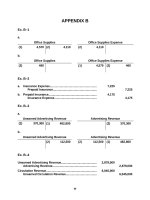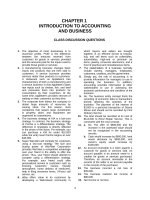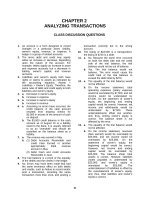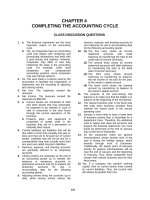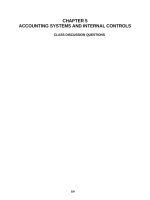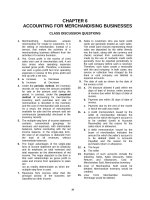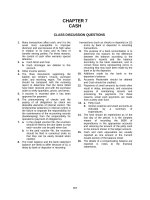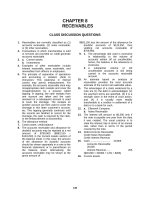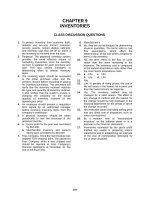Solution manual investments 10th by jones ch12
Bạn đang xem bản rút gọn của tài liệu. Xem và tải ngay bản đầy đủ của tài liệu tại đây (156.59 KB, 16 trang )
Chapter 12:
Market Efficiency
CHAPTER OVERVIEW
A chapter on market efficiency is a natural sequence to the
other two chapters in Part IV dealing with common stocks. It is
also desirable for students to be familiar with this topic at
this point so that market efficiency can be referred to when
discussing other topics, such as technical analysis or
fundamental security analysis.
Chapter 12 begins by explaining the rationale for arguing
that the market is efficient. It then proceeds to outline the
classic three forms of market efficiency laid out by Fama in
1970: weak, semi-strong, and strong.
Evidence on market efficiency is presented in some detail,
starting with weak form efficiency and concluding with strong
form efficiency. Within the weak form section the distinction is
made between statistical tests and trading rule tests. In the
semi-strong form section the concept of event studies is
developed, along with abnormal returns. Strong form evidence is
developed in considerable detail.
Chapter 12 presents a thorough analysis of the implications
of the EMH. This is important in getting students to think about
the real issues involved here. The implications for both
technical analysis and fundamental analysis are considered, along
with those for money managers. This discussion serves as a good
introduction to the last part of the chapter on possible market
anomalies.
Chapter 12 concludes with a complete discussion of possible
market anomalies or evidence of possible market inefficiency.
This evidence is divided into earnings announcements (which is
related to the unexpected earnings concept in Chapter 15), low
P/E ratios, the size effect, the January effect, and the Value
Line results.
The chapter ends with some conclusions about market
efficiency. It is important for students to think about what
they have learned and the implications for their approach to
investing in general and to such areas as technical analysis in
particular. The reference to the Keane article (Financial
169
Analysts Journal, March-April 1986) is important. This is a very
desirable article to read with regard to efficient markets.
Overall, most instructors will want to leave their students
with a balanced view of the efficient market controversy.
Certainly, the evidence on market efficiency cannot be ignored.
It is too well documented, and augmented by such factors as the
mediocre performance of professional fund managers. On the other
hand, to date no one has conclusively explained why the anomalies
exist. There may in fact be explanations, but they have not been
widely accepted. Much work in this area remains to be done.
Students must realize that in the area of efficient markets, as
in numerous other areas of investing, there is no definitive
answer, which is universally agreed upon and no definitive,
universal statement that can be made.
CHAPTER OBJECTIVES
To explain the rationale for efficient markets and what the
concept means.
To present the three forms of market efficiency and well
known empirical evidence concerning each of the three forms.
To consider the possible market inefficiencies (anomalies)
that have been widely discussed to date.
170
MAJOR CHAPTER HEADINGS [Contents]
The Concept of an Efficient Market
What is an Efficient Market?
[prices fully reflect information quickly and
accurately; diagram and explanation of adjustments to
information]
Why the U. S. Market Can Be Expected to Be Efficient
[many participants, widely available information
randomly
generated, investors react quickly to the new
information]
The International Perspective
[would seem reasonable that most foreign markets are
less efficient, but new evidence suggests strong
contemporaneous relationships among regional exchanges
that are open at the same time]
Forms of Market Efficiency
[weak, semistrong, strong]
Evidence On Market Efficiency
Weak-Form Evidence
[statistical tests of price changes, trading rule
tests, weak-form contra-evidence]
Semistrong-Form Evidence
[explanation of event study, abnormal return, and
cumulative abnormal return; review of evidence
involving stock splits, money supply changes,
accounting changes, dividend announcements, reactions
to other announcements]
Strong-form Evidence
[corporate insiders]
171
Implications of the Efficient Market Hypothesis
For Technical Analysis
For Fundamental Analysis
For Money Management
Evidence of Market Anomalies
Earnings Announcements
[unexpected earnings, SUE analysis]
Low P/E Ratios
[Basu studies, Dreman arguments]
The Size Effect
[small firms outperform large firms on risk-adjusted
basis]
The January Effect
[the strong performance in January by small-company
stocks]
The Value Line Ranking System
[the performance of the 5 ranking categories]
Other Anomalies
[brief mention of others, such as the neglected firm
effect]
Some Conclusions About Market Efficiency
[Keane’s arguments; the October 1987 market crash]
POINTS TO NOTE ABOUT CHAPTER 12
Tables and Figures
Figures 12-1 and 12-2 are to help students visualize
the adjustment process of stock prices to information and
the cumulative levels of efficiency, respectively.
172
Figure 12-3 on SUE categories is a striking figure. It
shows that stocks do not fully adjust to quarterly earnings
on the day of announcement, or shortly after. It also
suggests that insiders are at work before the earnings are
announced.
Figure 12-4 shows the record for the Value Line ranks
(without allowing for changes) for the period 1965-2000).
It is an impressive record for such a long period. Value
Line produces an even more impressive chart that does allow
for changes, but such a procedure would have generated a
prohibitive portfolio turnover rate, generating large
transaction costs and short-term capital gains.
Figure 12-5 is a Value Line graph showing a comparison
of the relative price performance of its Group 1 stocks with
four other strategies: low P/E, low cap (small size), low
price/book value, and low price/sales. The period covered
is 1965-2000. The figure suggests that Value Line’s Group 1
stocks outperformed the other four strategies by a
significant amount.
Boxed Inserts
Box 12-1 provides some international perspective on the
issue of market efficiency. Taken from The Economist, it
focuses on British portfolio managers and their success in
outperforming the market, or lack of success. This article
is a good discussion of the issues, and shows that other
countries, and other investment communities besides the
United States, must wrestle with the issue of market
efficiency.
173
ANSWERS TO END-OF-CHAPTER QUESTIONS
12-1.
An efficient market is defined as one in which the
prices of securities fully reflect all known
information quickly and accurately.
12-2.
The three (cumulative) forms of market efficiency
are:
12-3.
(a)
The weak form, which states that market data
(price and volume information) are reflected in
current prices and should be of no value in
predicting future price changes.
(b)
The semistrong form, which states that all
publicly known and publicly available data are
incorporated into stock prices.
(c)
The strong form, which states that prices fully
reflect all information, public and nonpublic
(i.e., information that can be restricted to
certain groups)
The conditions for an efficient market to exist are:
(a)
A large number of profit-maximizing investors
who actively participate in the market.
(b)
Information that is costless and widely
available to all at approximately the same
time.
(c)
Information that is generated in a random
fashion such that announcements are basically
independent of one another.
(d)
Investors that react quickly and accurately to
new information.
These conditions, which appear strict, are met quite
closely in reality. For example, while information
is not costless to produce, many market participants
receive it “free” (of course, it has to be paid for
in the commissions investors pay).
174
12.4.
Technical analysis relies heavily on known price
and volume data to predict future price changes.
The weak form of the EMH states that such data
should already be
reflected in current prices and therefore is of no
value in predicting future price changes.
12-5.
Semistrong form tests are tests of the speed of
price adjustments to public information. They seek
to determine if investors can use publicly available
information to earn excess returns.
12-6.
Two different ways to test for weak form efficiency
are:
12-7.
(a)
Statistically test the independence of stock
price changes, using such techniques as the
serial correlation test and the signs test.
(b)
Test specific trading rules that attempt to use
past price and volume data. One well-known
technical trading rule is the filter rule.
Statistical significance results from formal tests
in statistics, such as the calculation of the t
statistic or the F statistic. Such significance
relates to the probability of accepting or rejecting
certain hypotheses.
Economic significance refers to the possibility of
being able to actually exploit a statistical
dependence. After all costs are accounted for, can
excess returns be earned through such exploitation?
12-8.
If the EMH is true, there are several implications
for investors:
(a)
Technical analysis has no validity or, at the
very least, is seriously in doubt.
(b)
Conventional fundamental analysis--the type
done by the majority of analysts--is of little
value, producing, at best, average results.
What is necessary is to perform clearly
superior fundamental analysis.
175
(c)
As for money management activities, passive
strategies would receive much more emphasis.
Nevertheless, several tasks must still be
performed, such as diversifying, establishing
and maintaining the risk level, and being
concerned with the tax status of the investor
and his or her transaction costs.
12-9.
The performance of mutual fund investors can be a
test of semistrong efficiency in the sense that the
managers may be using nothing other than the
publicly available information to which all
investors have access. The semistrong form is
concerned with publicly available information. If
the managers are unable to outperform the market
(after all proper adjustments) using this
information, semistrong efficiency is supported.
12-10.
The money management activities for a portfolio
manager who believes that the market is efficient
will include at least the following:
12-11.
(a)
ascertain that the correct amount of
diversification has been achieved
(b)
achieve a level of risk appropriate for the
portfolio
(c)
maintain the desired risk level over time
(d)
be constantly aware of the tax implications of
the portfolio
(e)
seek to reduce transaction costs.
Market anomalies are research findings that do not
support market efficiency; that is, they are
evidence that inefficiencies do exist. These
results are in contrast to what would be expected in
a totally efficient market.
Well known anomalies include:
(a)
the SUE effect, or the proposition that the
adjustment of stock prices to quarterly
earnings announcements occurs with a lag
176
(b)
the P/E effect, or the proposition that low P/E
stocks will, on average, outperform high P/E
stocks
(c)
the size effect, or the proposition that small
capitalization stocks have earned higher riskadjusted returns than have large capitalization
stocks
(d)
the seasonal effect, or the proposition that
stocks have exhibited higher returns than
expected in
January. This could also include the monthly
effect, the weekend effect, and so forth.
(e)
the Value Line results, which seem to indicate
that this investment advisory service has
classified stocks into five groups that have
performed in a monotonic fashion, with very
impressive results for the top (expected best
performers) two groups
12-12.
If all investors believed that the market is
efficient, and numerous participants ceased the
pursuit and study of information about stocks, the
result could be less market efficiency. Obviously,
this statement would depend upon who is left to do
the analysis, and how much they do. The point of
this question is to stimulate thinking about what is
going on in the market in the way of information
gathering and processing.
12-13.
SUE is directly related to fundamental analysis.
First, earnings are a primary component of
fundamental analysis. Second, stock prices should be
expected to adjust to any unexpected information
contained in the earnings, and SUE captures this
unexpected element. The question is how long this
adjustment takes.
12-14.
Numerous types of events or information have been
used in semistrong form tests. The text discusses
the following: stock splits, money supply changes,
accounting changes, dividend announcements, and
reactions to various announcements such as major
world events and the information in the “Heard in
the Street” column of The Wall Street Journal.
177
Of course, earnings announcements have been studied
in regard to semistrong efficiency. Because SUE is
discussed in other sections of the book, it was not
included in the list discussed above; however,
earnings announcements are one of the major items to
be studied in this regard. Furthermore, the other
anomalies discussed later in the chapter, such as
the P/E ratio, involve tests of semistrong
efficiency.
Other studies have examined management forecasts,
new issues, and options. Finally, as discussed
elsewhere, tests of mutual fund performance can be
regarded as semistrong efficiency tests.
12-15.
In an efficient market, prices reflect information
quickly and accurately. Investors could expect to
buy and sell stocks at “fairly-valued” prices.
Corporations could assume that when they make good
decisions, or experience favorable events, the
corporation’s stock price will reflect this. Funds
will be better allocated in such a market.
Furthermore, resources would not be devoted to
pursuits of dubious or no value, such as technical
analysis.
12.16.
No! Upward trends are not inconsistent with weak
form efficiency. Price changes can be random
around an upward trend. Any random series can show
clear trends.
12-17.
Security analysts are still needed in an efficient
market to disseminate information and value
securities based on their estimates. If this were
not being done, the market could become inefficient.
The important question here involves the number of
analysts needed to perform this role, and the type
of analysis they do.
12-18.
The fact that a mutual fund, or any portfolio, has
outperformed the market for the last four years is
not a very significant finding. To be potentially
significant, we must show first of all that the
results are on a risk-adjusted basis, and that all
expenses relative to a buy-and-hold strategy has
178
been accounted for. Until this is done, the
statement is basically meaningless.
12-19.
To conduct a fair test of a technical trading rule,
certain adjustments must be made, including:
(a)
risk
(b)
transaction and other costs
(c)
consistency
(d)
out-of-sample validity
12-20.
Filter rules are related to timing strategies,
indicating when to be long or short. Filter rules
should be compared with a buy-and-hold strategy.
12.21.
An analysis of specialists is a test of strong form
efficiency. They possess information (such as a
knowledge of limit orders) not publicly available,
and the issue is whether they can earn excess
returns.
12-22.
Some researchers writing about the size anomaly, in
particular Banz and Reinganum, have attributed it to
a misspecification of the CAPM. Size may be a proxy
for some other variable, or may be highly correlated
with other variables and be picking up part of their
effects.
12-23.
Directly testing the profitability of insider
trading involves strong form efficiency. And tests
of insider activity indicate that they do earn
returns in excess of those expected.
Investors can use the insider reports that must be
filed with the SEC and are, therefore, publicly
available. Several advisory services report these
transactions. A test of whether investors can use
such publicly available information to earn excess
returns is a test of semistrong efficiency.
12-24.
Mutual fund data can be used to test strong form
efficiency by assuming that mutual fund managers are
in possession of non-public information. Since they
are full-time managers with staffs to assist them,
179
have adequate resources for research, and offer the
potential for brokers to earn large commissions, it
is reasonable to expect them to discover information
more quickly than the average investor.
Mutual fund data can also be used to test semistrong
form efficiency. If all publicly available
information is quickly reflected in stock prices,
and mutual funds use only publicly available
information, they should not be able to earn excess
returns.
12-25.
If the market is semistrong efficient, you would
expect to see an immediate adjustment at the time
the information becomes available. On a graph with
stock price as the vertical axis and time as the
horizontal axis, think of the price between period 0
and period 1 as a horizontal line extending from the
stock price on the vertical axis.
At time period 1, the price would adjust immediately
to the new (and assumed) higher price; therefore, on
the graph there would be a small vertical line
representing this immediate adjustment to the new
and higher justified level. For completeness in
this simple situation, you could then draw a new
horizontal line representing the price between
period 1 and period 2.
P
r
i
c
e
│
│
│
│
┌─────
├─────┘
│
│
└───────────────────────────────────────Time
0
1
2
3
If there is a lag in the adjustment of the price to
this information, there would not be the sharp,
immediate adjustment at period 1. Rather, this
adjustment would be gradual.
12-26.
The SUE analysis is not related to technical
analysis, which uses market data in an attempt to
180
forecast future price changes. SUE is part of
fundamental analysis because it is concerned with
the adjustment of stock prices to earnings
announcements, and earnings are a primary
fundamental variable.
12-27.
The standard definition of an operationally
efficient market is one with the lowest possible
prices for transactions services. This is different
from the informational efficiency discussed in this
chapter.
According to Keane, an operationally efficient
market is one in which only a relatively few
investors have the skill to detect a divergence
between price and semistrong value. These few
investors can earn economic rents. Such
opportunities are not available for most investors.
CFA
12-28.
a.
The notion that stock prices already reflect all
available information is referred to as the
efficient market hypothesis (EMH). It is common to
distinguish among three versions of the EMH: the
weak, semi-strong, and strong forms. These versions
differ by their treatment of what is meant by “all
available information.”
The weak-form hypothesis asserts that stock prices
already reflect all information that can be derived
from studying past market trading data. Therefore,
“technical analysis” and trend analysis, etc., are
fruitless pursuits. Past stock prices are publicly
available and virtually costless to obtain. If such
data ever conveyed reliable signals about future
stock performance, all investors would have learned
already to exploit such signals.
The semi-strong form hypothesis states that all
publicly-available information about the prospects
of a firm must be reflected already in the stock’s
price. Such information includes, in addition to
past prices, all fundamental data on the firm, its
products, its management, its finances, its
181
earnings, etc., that can be found in public
information sources.
The strong-form hypothesis states that stock prices
reflect all information relevant to the firm, even
including information available only to company
“insiders.” This version is an extreme one.
Obviously, some “insiders” do have access to
pertinent information long enough for them to profit
from trading on that information before the public
obtains it. Indeed, such trading - not only by the
“insiders” themselves, but also by relatives and/or
associates - is illegal under rules of the SEC.
For the weak-form or the semi-strong forms of the
hypothesis to be valid does not require the strongform version to hold. If the strong-form version
was valid, however, both the semi-strong and the
weak-form versions of efficiency would also be
valid.
b.
Even in an efficient market, a portfolio manager
would have the important role of constructing and
implementing an integrated set of steps to create
and maintain appropriate combinations of investment
assets. Listed below are the necessary steps in the
portfolio management process:
1)
Counseling the client to help the client to
determine appropriate objectives and identify
and evaluate constraints. The portfolio
manager together with the client should specify
and quantify risk tolerance, required rate of
return, time horizon, taxes considerations, the
form of income needs, liquidity, legal and
regulatory constraints, and any unique
circumstances that will impact or modify normal
management procedures/goals.
2)
Monitoring and evaluating capital market
expectations. Relevant considerations, such as
economic, social, and political
conditions/expectations are factored into the
decision making process in terms of the
expected risk/reward relationship for the
182
various asset categories. Different
expectations may lead the portfolio manager to
adjust a client’s systematic risk level even if
markets are efficient.
3)
The above steps are decisions derived
from/implemented through portfolio policy and
strategy setting. Investment policies are set
and implemented through the choice of optimal
combinations of financial and real assets in
the marketplace - i.e., asset allocation.
Under the assumption of a perfectly efficient
market, stocks would be priced fairly,
eliminating any added value by specific
security selection. It might be argued that an
investment policy which stresses
diversification is even more important in an
efficient market contest because the
elimination of specific risk becomes extremely
important.
4)
Market conditions, relative asset category
percentages, and the investor’s circumstances
are monitored.
5)
Portfolio adjustments are made as a result of
significant changes in any or all relevant
variables.
CFA
12-29.
c
CFA
12-30.
a
CFA
12.31.
d
CFA
12-32.
d
183
ANSWERS TO END-OF-CHAPTER PROBLEMS
12.1.
SUE = (Actual Earnings - Expected Earnings) /
Standard Error of Estimate
=
(.50 - .30) / .05 = 4.0
This would be a good buy on the basis of the
research that has been done because SUE values over
3.0 have, on average, been associated with positive
excess returns, and the higher the SUE value, other
things equal, the better. A SUE of 4 or better
would put this stock in the top decile of SUE stocks
based on previous studies.
184
